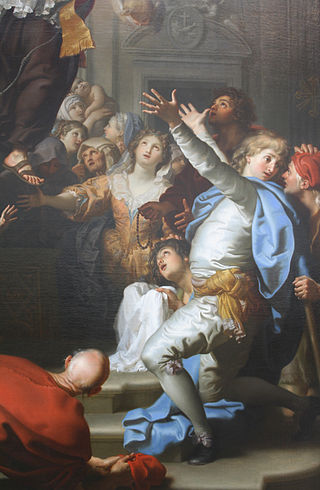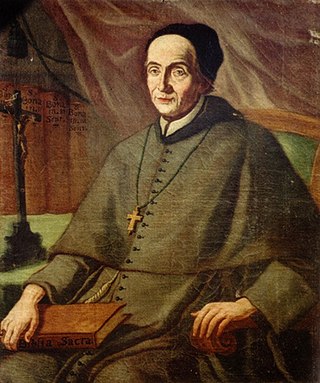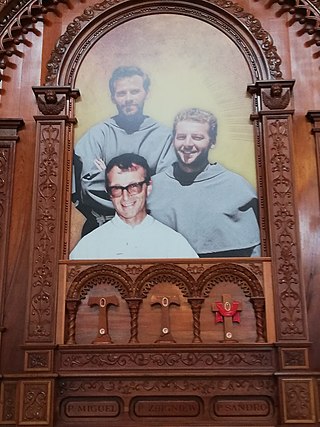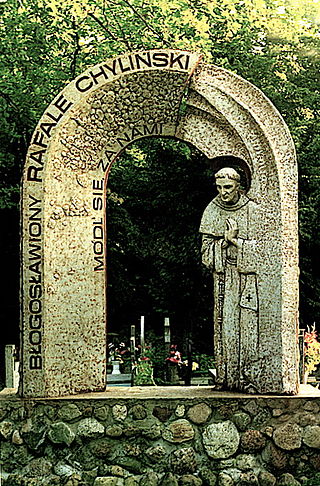Giovanni Battista Righi was an Italian Roman Catholic priest and a professed member from the Order of Friars Minor. He was known for ascetic life and for his preaching and healing abilities.

Bernardo da Corleone was a Sicilian Capuchin friar.

Johannes Ludovicus Paquay, also known as Valentinus, was a Belgian Roman Catholic priest and a professed member from the Order of Friars Minor. He was a popular confessor and noted preacher while serving in various leadership positions in the house he was stationed in; he was also known for his popular devotion to the Eucharist and the Sacred Heart and promoted these devotions to the faithful and to his conferees alike.

Tommaso da Cori - born Francesco Antonio Placidi - was an Italian Roman Catholic priest and a professed member of the Order of Friars Minor who lived as a hermit for much of his religious life. He gained fame as a noted preacher throughout the region where his hermitage was located and for this became known as the "Apostle of the Sublacense".

Antonio Lucci, born Angelo Nicola Lucci, was an Italian Roman Catholic professed member from the Order of Friars Minor Conventual and served as the Bishop of Bovino from 1729 until his death.

Tommaso da Olera - born Tommaso Acerbis was a Roman Catholic Italian friar of the Capuchins. Leading a life of humility and service, Acerbis, initially a shepherd with no formal education, joined the Order of Friars Minor Capuchin in Verona at the age of seventeen. He served in various convents, offering spiritual guidance to the sick and impoverished. Acerbis spoke out against the spread of Lutheranism, defending the Roman Catholic Church through his love for "the impassioned Christ". His influence extended to sponsoring convents and spiritually guiding notable individuals, including Bernardina Floriani and scientist Ippolito Guarinoni. Acerbis's devotion earned him papal veneration, with Pope John XXIII recognizing him as "a saint and a true master of the spirit". The beatification process, initiated in 1967, culminated in his proclamation as Venerable on 23 October 1987. A miracle further validated his cause, leading to beatification on 21 September 2013, presided over by Cardinal Angelo Amato on behalf of Pope Francis.

The Three Martyrs of Chimbote were a group of two Polish Franciscan priests and one Italian missionary priest murdered in Peru in 1991 by the Shining Path communist guerillas. Michał Tomaszek and Zbigniew Adam Strzałkowski, and Alessandro Dordi were murdered on 9 August and 25 August 1991 respectively.
Maria Caterina Troiani was an Italian Roman Catholic charitable worker who assumed the name of "Maria Caterina of Saint Rose" when she became a nun. Troiani established the Franciscan Missionaries of the Immaculate Heart of Mary. She was a member of the Third Order of Saint Francis.
Giuseppe Oddi was an Italian Roman Catholic professed religious - though not a priest - of the Franciscan Order of Friars Minor Capuchin. He felt drawn to religious life after his adolescence and was resolved to become a Franciscan upon seeing the example that Mariano da Roccacasale set. Upon his profession of vows he assumed the religious name of "Diego da Vallinfreda". Oddi was beatified - alongside Mariano da Roccacasale - when Pope John Paul II presided over the late Franciscans' beatification on 3 October 1999.

Jakub Strzemię was a Polish Roman Catholic archbishop and a professed member of the Order of Friars Minor. He served as the Archbishop of Halicz from 1392 until his death when the archdiocese was incorporated into that of the Archdiocese of Lviv.

Blessed Ladislas of Gielniów was a Polish Roman Catholic priest and a professed member of the Order of Friars Minor. He was an observant of the Rule of Saint Francis of Assisi and served his order in various capacities that included both a doorkeeper and as its provincial. He also travelled across Poland to evangelize to the faithful and was a noted preacher.
Mariano da Roccacasale - born Domenico di Nicolantonio - was an Italian Roman Catholic professed religious from the Order of Friars Minor. He was of peasant stock and entered the order in his twenties as a professed religious rather than as an ordained priest. He was an influence in the decision of Giuseppe Oddi joining the Franciscans after their 1863 encounter. He became titled as a Servant of God under Pope Leo XIII on 12 December 1895 with the commencement of the canonization cause. He received the title Venerable in 1923 under Pope Pius XI; Roccacasale was beatified - alongside Oddi - when Pope John Paul II presided over the late Franciscans' beatification on 3 October 1999.

Khalīl al-Haddād, also known as Ya'Qūb from Ghazīr, was a Lebanese Roman Catholic priest and a professed member of the Order of Friars Minor as a Capuchin friar. He was the founder of the Franciscan Sisters of the Cross. He was a noted preacher and founder of various orphanages and schools across Lebanon. Presidents of the state honored him with various awards while the populace compared him to the likes of Saint Vincent de Paul and Saint Giovanni Bosco.

Luca Antonio Falcone – in religious life Angelo – was an Italian Roman Catholic priest and a professed member of the Franciscan Order of Friars Minor Capuchin in Cosenza. Falcone had a rough call to religious life after several entries and exits into the order and he later served as a noted preacher across southern Italian cities such as Catanzaro and Salerno after his first few sermons attracted little following. He became titled as both the "Angel of Peace" and the "Apostle of the South".
Giovanni da Penna was an Italian Roman Catholic priest and a professed member of the Order of Friars Minor. He became a Franciscan in 1213 after hearing Fra Filippo - one of the disciples of Francis of Assisi - preach. He spent over two decades in France where he oversaw the establishment of Franciscan houses before returning to the Italian peninsula where he served his life in quiet cloistered retirement.

Andrea Caccioli was an Italian Roman Catholic priest and a professed member from the Order of Friars Minor. He became the first priest to enter the Franciscans and served as one of the disciples of Francis of Assisi himself - the priest was at his deathbed and attended his canonization. The friar preached across Italian cities such as Rome and Padua as well as in France and he became noted for miracles performed during his lifetime.
Antonio da Stroncone was an Italian friar of the Order of Friars Minor. He became a member of that order in his youth after cultivating a strong devotion to Francis of Assisi during his childhood with his parents who were members of the Third Order of Saint Francis.

The Martyrs of Tlaxcala were three Mexican Roman Catholic teenagers from the Tlaxcaltec people of the modern state of Tlaxcala: Cristobal (1514/15–1527) and the two companions Antonio (1516/17–1529) and Juan (1516/17–1529). The three teenagers were converts from the Nahua religion of their families to the Catholic Church in Mexico and received their educations from missionaries of the Order of Friars Minor who baptized them while evangelizing in the area. Their activism and evangelical zeal led to their honour killings by fellow Tlaxcaltec people, including their close relatives, who detested their newfound faith and recognized them as dangers to their values and rituals.

Melchor Chyliński - in religious Rafał - was a Polish Roman Catholic priest and a professed member from the Order of Friars Minor Conventual. He first served as a soldier but decided to instead become a priest and so entered the Franciscans and made his profession prior to ordination. He also became known for his simplistic preaching and for his generous outreach to the poor through the distribution of clothing and food.

Gabriel Ferretti was an Italian Roman Catholic priest and a professed member of the Order of Friars Minor. He was an ancestor to both Cardinal Gabriele Ferretti and Pope Pius IX having been descended from a long noble lineage. Ferretti entered the religious life after becoming of age and soon after his ordination held two important leadership positions in the order. He set about restoring run down Franciscan convents in the region as well as seeing to the establishment of new ones to deal with an influx of new novices.














